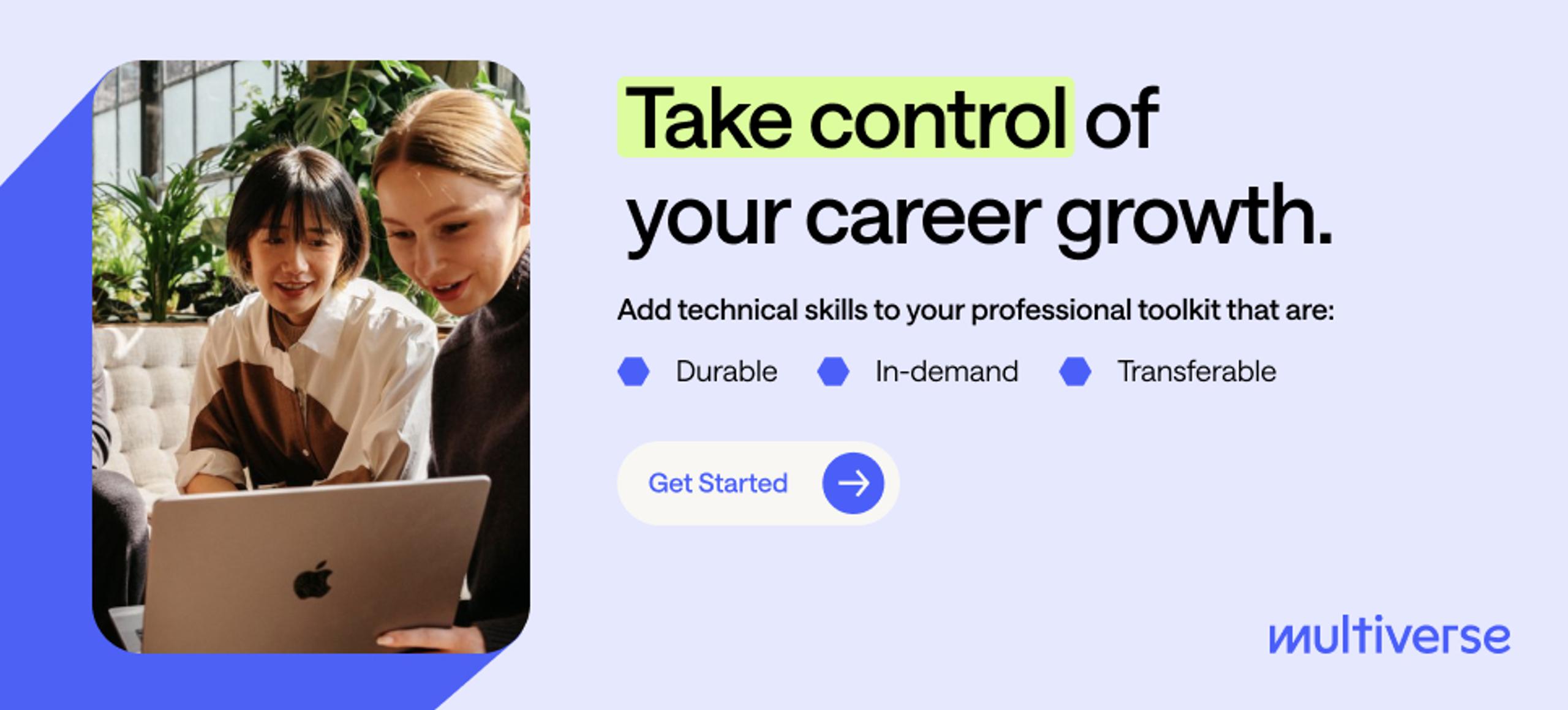In 2023, Starbucks announced the launch of a new strategic initiative, “Triple Shot Reinvention with Two Pumps.(opens new window)” This plan uses data analytics and technology to revamp the popular coffee chain’s operations and marketing. The company will improve its mobile app and use generative artificial intelligence (GenAI) to improve product development.
Starbucks is only one of many top companies using digital strategy to transform business models. Leaders across industries have embraced innovative technology-driven solutions — from McDonald’s(opens new window) use of personalized digital offers to attract customers, to Macy’s, Inc.(opens new window), which developed an immersive online fashion platform to compete in the era of ecommerce.
This growing push for digital transformation has led to a surge in demand for digital strategy professionals. Zippia(opens new window) predicts that the number of jobs in this field will increase by 19% between 2018 and 2028. If you’re interested in a digital strategy career, there are a few factors to consider. Below, we explore key components of a digital strategy, career paths, salaries, and more.
What is a digital strategy?
A digital strategy is a comprehensive plan using data and digital technologies to achieve business goals and promote long-term growth. Businesses develop digital strategies to gain competitive advantages and adapt to new technology.
Digital strategies vary widely between companies but generally include these core pillars:
- Data analytics - Digital Strategists use statistical techniques to analyze performance, detect patterns, and identify growth opportunities.
- Digital advertising - Businesses pay to promote their products and services online. Popular digital advertising channels include affiliate marketing, website display banners, and pay-per-click ads.
- Digital marketing - Companies use email, social media, and other digital channels to build their brand reputation and strengthen customer relationships.
- Customer service - Digital technology can improve the customer experience and foster loyalty. For instance, businesses can offer digital loyalty programs and use AI-powered chatbots to answer client questions.
- Search engine optimization (SEO) - Digital Strategists use SEO tactics to improve a website’s ranking in search engine results pages. Common techniques include using relevant keywords in website content and creating internal links.
A successful digital strategy typically addresses multiple areas at once. Say, for example, a pet supply company wants to address lagging same-store sales and raise brand awareness. A Digital Strategist could use data analytics to assess consumer behavior, feedback forms, and social media mentions.
Based on the insights they gain, the Digital Strategist can develop personalized marketing campaigns and targeted advertising. They can also recommend ways to boost in store sales, such as optimizing staffing to reduce checkout times.
Why create a digital strategy?
A successful digital strategy offers many benefits for businesses in all industries. Here are a few advantages of this approach.
Achieve digital transformation
A digital strategy allows companies to manage transformation actively. This approach uses data-driven insights to select the best digital tools and create new business models.
Take Chipotle Mexican Grill(opens new window), which traditionally focused on counter service. In 2018, the company revamped its business model and updated store layouts to include drive-thru pick-up lanes for digital orders. Chipotle’s mobile sales increased, leading to the rapid growth of “Chipotlanes.”
Increase brand awareness
Organizations can significantly boost brand awareness by incorporating digital marketing channels in their digital strategy. Blog posts, influencer marketing, social media campaigns, and other methods expand a brand’s online presence. Companies can also use these channels to reach new customers who might not discover their brands through traditional advertising.
Level up digital maturity
Data maturity measures the effectiveness of an organization’s data management and analytics practices. The Office of Data Governance’s Data Management Maturity Model(opens new window) includes five key areas:
- Analytics
- Culture
- Data
- People
- Technology
A digital strategy advances digital maturity by helping companies use information more efficiently. For example, a Digital Strategist could use machine learning models to automatically clean and analyze enormous datasets. Companies can also adopt new digital platforms to manage information effectively.
Engage existing and new customers
Effective digital strategies often include tactics to increase client engagement and attract new leads. For example, analytics techniques allow organizations to study customer expectations and preferences.
You can use these insights to tailor social media posts for your target audience. You can also use an email marketing platform to send clients personalized product recommendations based on browsing histories.
Get ahead in a competitive environment
An innovative digital strategy gives a company a competitive advantage. Organizations can use new technologies to distinguish their products and services from other brands. Digital tools also streamline business processes and boost productivity, leading to long-term cost savings.
For example, Amazon(opens new window) uses sophisticated robot systems to monitor warehouse inventory and retrieve products for human employees. This digital technology expedites delivery and reduces worker injuries. These benefits help Amazon maintain its role as a leader in the e-commerce industry.
Key components of a digital strategy
An effective digital strategy includes these essential elements:
- Goals - Specific objectives you plan to achieve with digital initiatives. These goals should fit into the overall business strategy.
- Target audiences - The audiences you want to engage with your digital strategy. Categorize them based on demographics, purchasing behaviors, interests, and other criteria.
- Data - Information gathered, managed, and analyzed to inform decision-making. Relevant data sources include online reviews, social media mentions, and financial transaction records.
- Data governance - Practices and policies that regulate how organizations manage and store information. For instance, a business can use access controls and encryption techniques to safeguard datasets.
- Digital leaders - These experts spearhead the digital strategy and foster a data-driven culture. They may include Digital Marketing Managers and Chief Digital Officers.
- Digital platforms - The digital ecosystems used to execute the strategy and promote the brand. Popular platforms include Google, Meta, and Twitter/X.
- Digital technology - Tools used to carry out the business strategy, such as augmented reality, email marketing software, and machine learning algorithms.
- Key performance indicators (KPIs) - Metrics to measure the digital strategy’s strategic impact. Relevant KPIs include conversion rate, return on investment (ROI), and website traffic.
These components work together to boost business performance and enhance customer interaction. For example, digital leaders can create transparent data governance policies to build customer trust. Organizations can also use a mobile payment app to save clients time and drive mobile sales.
Developing a digital strategy
Creating a digital strategy may sound complicated, but it’s easy to get started. Follow these steps to develop a comprehensive plan.
Establish clear goals
Start by defining your digital ambition. Follow the SMART framework(opens new window) by creating goals that are:
- Specific
- Measurable
- Achievable
- Realistic
- Timely
For example, you could aim to increase sales by 15% in the next six months. Additional goals could include boosting social media engagement by 25% and improving your website’s visibility in search engine rankings.
Build your A-team
Appoint a team to develop and implement the digital strategy. These employees should have a rich understanding of business decision-making, digital technology, and strategic analytics.
Small companies may only need a Data Analyst to interpret information and a Digital Marketing Specialist to promote the brand. Larger organizations may have more specialized roles, such as UX Designers and Digital Advertising Specialists.
Use strategic analytics
Strategic analytics uses statistical methods and software to analyze datasets and gain actionable insights. Organizations can use this method to understand their target audience, gain greater clarity about performance, and identify areas of improvement.
Popular strategic analytics frameworks and tools include:
- Apache Spark - Process and analyze enormous datasets efficiently
- Structured Query Language (SQL) - Build, manage, and manipulate relational databases
- Microsoft BI and Tableau - Create graphics to visualize patterns and trends in datasets
Formulate your strategy
Use the insights you gain from analytics to develop your digital strategy. Here are a few examples of tactics you could include in this plan:
- Create a mobile app with exclusive discounts to increase sales.
- Develop new services that use digital technology to generate revenue.
- Partner with social media influencers to promote your brand.
- Produce educational videos on topics closely related to your products.
- Send clients emails with interactive polls to collect feedback.
Choose your channels
Research your target audience to identify the best marketing channels(opens new window). For example, 92% of people aged 30 to 49 use YouTube, and 75% use Facebook. Select digital channels that resonate with your audience and tailor your content to their interests.
Develop and execute your action plan
Create an in-depth plan for implementing your digital strategy. Start by breaking down each part of the plan into manageable tasks and delegating them to the team.
Set milestones and deadlines to track progress. Adjust your action plan as needed if you encounter challenges or new opportunities.
Measure performance
Track relevant KPIs to evaluate the effectiveness of your digital business strategy. The specific metrics you use will depend on your digital channels and goals but may include:
- Customer lifetime value - The total earnings you generate from each customer
- Open rate - The percentage of email recipients who open your messages
- Organic traffic - The number of people who visit your website after finding it in organic search results
- Social media engagement rate - The percentage of users who like, comment on, and share your content
These indicators can help you identify and focus on the tactics that have the greatest lift. For instance, if your email marketing campaign increases revenue, you may devote more resources to this channel to optimize your success.
Roles in digital strategy: Titles, salary, and career outlook
Companies need digital talent to develop and execute their business strategy. Many of these organizations offer six-figure salaries for people with the right experience and skills. Specific job roles and titles vary by company and industry, but here are a few common careers.
Digital Strategist
A Digital Strategist develops and implements techniques to promote their company’s brand, products, and services.
Typical responsibilities:
- Collaborate with product development and sales teams to promote the brand
- Coordinate marketing campaigns across multiple channels
- Engage with clients on social media
- Measure the long and short term impact of marketing campaigns
- Use analytics to interpret market trends and recommend promotional strategies
Salary:
- Starts at - $85,000
- Average - $113,000
- Highest earners - up to $157,000
Source: Glassdoor
Digital Marketing Manager
A Digital Marketing Manager plans, implements, and assesses digital marketing strategies. They often oversee cross-functional teams to create cohesive marketing campaigns.
Typical responsibilities:
- Continuously learn new marketing tools and trends
- Design paid advertising campaigns
- Generate and convert new leads
- Plan multi-channel marketing campaigns
- Track performance and report results
Salary:
- Starts at - $92,000
- Average - $123,000
- Highest earners - up to $167,000
Source: Glassdoor
Chief Digital Officer
A Chief Digital Officer shapes the digital business strategy for an entire organization. They use new technology to drive digital transformation and develop innovative digital initiatives.
Typical responsibilities:
- Develop a seamless data ecosystem
- Educate stakeholders about strategic options
- Foster a technology-driven culture
- Manage priority initiatives
- Supervise the adoption of new technologies
Salary:
- Starts at - $307,000
- Average - $410,000
- Highest earners - up to $574,000
Source: Glassdoor
Preparing for a digital strategy career
There are many ways to gain the skills you need to land a digital strategy role.
Some aspiring Data Strategists earn a bachelor’s degree in data science, marketing, and other relevant fields. These majors provide foundational knowledge, but students may not gain hands-on experience. Additionally, a college education averages $38,270 per year(opens new window) — making this path unobtainable for some.
Fortunately, you can also leverage an internship, online course, or on-the-job training you acquire the skills you need to launch a new career.






